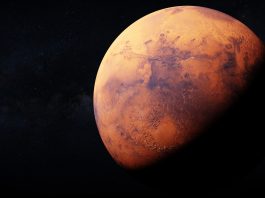Scientists at the University of Manchester have developed a cosmic concrete made from space dust and astronaut blood in an effort to create options for affordable space housing.
As it stands, transporting just one brick to Mars would cost an estimated £1m, thus making the future development of a Martian colony an incredibly expensive endeavour. Now, scientists at the University of Manchester have come up with a method to overcome this current barrier to space housing by establishing a concrete-like material comprised of terrestrial dust, as well as the blood, sweat and tears of astronauts.
In this novel study, which has been published in Materials Today Bio, a protein from human blood, mixed with a compound from urine, sweat or tears, is capable of glueing together simulated moon or Mars soil to create a material that is stronger than standard concrete and well suited for construction work in extra-terrestrial environments.
Housing development in space
This high cost of transporting materials means that in the future, when property is being developed on Mars, colonists will not be able to take materials with them but will have to utilise resources that can be found in space in order to build housing.
This method is known as in-situ resource utilisation (ISRU) and generally centres on the utilisation of loose rock and Martian soil (known as regolith) and sparse water deposits. However, there is one currently unnoticed resource that will also be available on any crewed mission to Mars: the crew members themselves.
The researchers at the University of Manchester have shown that human serum albumin, a ubiquitous protein in blood plasma, can behave as a binder for simulated moon or Mars dust to develop a concrete-like material. The subsequent material, called AstroCrete, had compressive strengths as high as 25 MPa (Megapascals), about the same as the 20–32 MPa seen in typical concrete.
Blood, sweat and tears
As well as this, the team discovered that combining urea – a biological waste product that the body generates and excretes through urine, sweat and tears – has the ability to further enhance the compressive strength by over 300%, with the best performing material having a compressive strength of almost 40 MPa, substantially stronger than standard concrete.
Dr Aled Roberts, from The University of Manchester, explained that the novel method holds significant advantages over other proposed construction methods on the moon and Mars.
“Scientists have been trying to develop viable technologies to produce concrete-like materials on the surface of Mars, but we never stopped to think that the answer might be inside us all along”, he commented.
The team calculated that it was possible to produce over 500 kg of high-strength AstroCrete during a two-year mission on the surface of Mars by a crew of six astronauts. If employed as a mortar for sandbags or heat-fused regolith bricks, every crew member could create enough AstroCrete to increase the habitat to support another crew member, doubling the housing available with every following mission.
Animal blood was historically used as a binder for mortar. “It is exciting that a major challenge of the space age may have found its solution based on inspirations from medieval technology”, added Dr Roberts.
The team explored the underlying bonding mechanism and found that the blood proteins denature, or ‘curdle’, to form an extended structure with interactions known as ‘beta sheets’ that tightly holds the material together.









